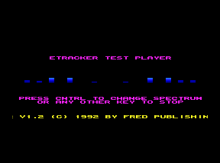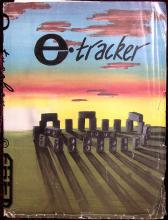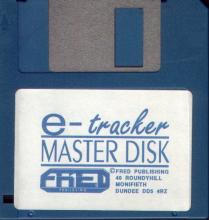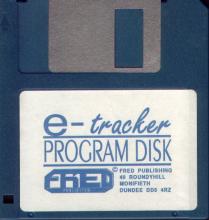E-Tracker
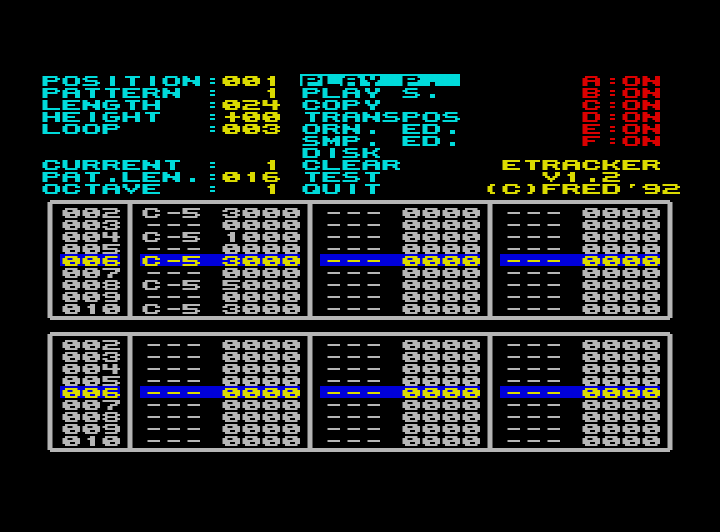
Download
Download
Release Year
Copyrights
Copyright Provenance
Description
The first commercial ‘tracker’ music composition program for the Coupé, based on the ZX Spectrum port of the Amiga SoundTracker program by Jarosław Burczyński
Released version 1.2 from Fred Publishing was followed by an internet released version 2.3 with a slightly different format but critically lacking a compiler.
Differences:
- Number of patterns increased from 32 to 256
- Variable length pattern data - patterns no longer allocated as fixed space in module data to save space
- Tune and Author text field names
In 2023 Anton Javorček wrote a converter to allow back-porting of the format.
Reviews
Review by Lee Willis from the Sam Coupé Scrapbook
Excuse me for being a bit late with this review! As by some lucky fluke of chance (Hah!) Lee has sent me a load of notes about E-Tracker, and wants me to put those arkward notes into some sort of review. Ah well, here goes… Considered by many (especially ESI) as the “best 8-bit music utility yet” which I could also be as bold as to say it compares well to other 16 bit utilities I have seen, this is indeed a stiff bit of competition. This music utility is exclusively designed to use every last drop of the SAA1099 sound chip in terms of it’s love juices (ahem!). That means 2048 tones, 96 notes, 8 octaves and 6 channel sound with full control of left and right stereo speakers. The last music utility was of course, The Sound Machine. Reasonably priced at 14.99, this was pretty to look at, but the disadvantage of being a bit user-friendly to any bod with a mouse, and abuser-friendly to the saps on keys. I suffered terribly from the sluggish cursor movement, but enough of my troubles! Help is here…
The utility comes in a professionally painted box, with a manual (surprisingly) in English. I know that ESI (the blokes who wrote this) are foreign, and their English in their scrollies is terrible, but I can find little wrong with this manual! A reasonable size of 20-odd pages, this talks you through the utility in a damn-spunky manner. You also get two disks - the E -Tracker and compiler disk, and a programme disk. More on these later…
The layout of the utility is exact to the Spectrum’s public domain Soundtracker utility, with the exception of a few additions to fit the Coupe’s huge requirements. The top half of the screen contains many functions which can be highlighted with a cursor bar. The right of the screen has a channel control, so you can switch on and off the 6 channels using the function keys. The bottom of the screen is gridded off into six boxes, where you can easily edit music. The six boxes relate to the 6 channels(!).
First things first. After some looking over the instruction manual, we can try our luck on the Instrument editor. This is a wonder of modern music technology - instruments on E-Tracker (36 is the maximum) make up the music, and are made up themselves of 256 different elements per instrument. I won’t go into too much detail, but you can control noise, tone, pitch, noise frequency and stereo with this editor to better effect than the Sound Machine. Tips can be gained from the manual, and several demo music pieces which you can nick…erm, use creatively to your heart’s content.
There is another editor called the Ornament editor, which is basically a simplified version of the Instrument editor. From what it says on Lee’s “review”, it is basically a mixer of instruments to produce a different sound. At least, that what I think it says - Lee’s handwriting is awful! Once you are done with this, you can get to writing the music. Unchanged from the Spectrum Soundtracker basic layout, this is the way to write music on E-Tracker…
E -1 2345
Simply, the letter is note “E”. It is a flat E, due to the presence of a - sign (smart arses will gather that E# is a sharpE and E on it’s own is normal E). The number after E is the octave number. Then, there is a brilliant combination of numbers for various functions. The numbers are Instrument, Ornament, Command and Value for that note. The first two are self-explainatory, but Command is a selection of commands you can use for the note (like echo and wave effects) and value is also used to manipulate the command. It delves much deeper in the manual.
Cutting and Pasting, or Copying huge chunks of code is more-or-less straightforward (though you will need to consult the manual, though it is a great consolation that Sound Machine editing was trecharously difficult to the newcomer) and you can manipulate this chunk to your advantage. Once complete, your masterpiece can be saved for future use, or compacted in the Compiler, then saved.
This Compiler is basically a space-saver, as well as a way to use the music in BASIC or Machine Code (same as Sound Machine!) with no hassle. The compiler has a 95% compression rate, which means in lay-mans terms that a 100K piece of music is squashed to 5K. It works on the principle of repeating pieces of music, so the Compiler may waver a little on this 95% rate, but not too much.
As a beginner, I - I mean Lee, made up some “pretty cool” tunes and ditties, which he assures me he made up with minimal hassle, and he will use in a demo pretty soon. So Lee has also scored the utility for himself! (Isn’t that nice of him..!)
| Area | Score |
|---|---|
| Graphic Ability | N/A |
| Coupe Power | 80% |
| Lastability | 95% |
| Overall | 91% |
Your Sinclair review, (Recovered) courtesy of the YS Rock 'n' Roll Years YS91
E-Tracker (SAM)FRED £29.99 Jul 1993
Soundtrackers. Music sequencer programs. Roll those words around your mouth. I'm sure you all know the story behind these darned 'trackers, but for those of you who take five year long holidays in Mozambique, here's the story. (Steve sways from side to side in ultimately unsuccessful attempt to reproduce cinematic flashback effect.)
In the beginning there was the Amiga, and an all-round good egg called Karsten Obarski. Being such a nice fellow, Karsten came up with Soundtracker. It was popular, to say the least, and was ripped off quite a bit. (Yikes.) Then Mahoney and Kaktus did Noisetracker, Fairlight did Startrekker (ho ho) and various other people did their little bits to help the soundtracker concept evolve to its full potential, or something.
One bright, crisp, Polish day, Jarosław Burczyński (BZYK) decided to copy it to the Speccy, because all other music creation programs, especially Wham! The Music Box were complete crap. (Yea verily.) And, to put it frankly, the world of Spectrum demos was changed overnight. Well, obviously 'overnight' is a relative term. It probably was an overnight revelation if you happened to live within BZYK's postal district, thus ensuring your copy of the prog arrived within 24 hours. Programmers further afield had to wait a little longer, so perhaps it would be fairer to call it an 'over a variable amount of time' revelation. Yes. Sorry, where was I?
Life went on, and the SAM was released. But lo! There was no 'tracker on the Coupe! So, one equally bright, crisp, Polish day, Mat and Kaz of ESI took the production of the wonder program into their hands, and after numerous late nights, E- Tracker was born. (Lo! Yea! Etc.)
The SAM has been crying out for a decent music package for ages, as far as I recall. Correct me if I'm wrong, but there's only been The Sound Machine and that made little more than a shallow dent in the huge lump of Silly Putty that forms the SAM user base. Let's hope that this one is received a little better.
Okay, so on first glance it looks more like a freaky monitor than a music program, with its six windows displaying lots of pure hex. This is what has made the 'tracker family popular, believe it or not. Rather than traditional music notation, the whole caboodle is organised as a rather funky sequencer, and the hex gives you near total control over the entire soundchip.
What distinguishes E-Tracker from the Speccy's dearly beloved Soundtracker is the fact that it's a piece of commercial software. (The original was PD and - shriek! - free.) However, this isn't as bad as it might sound to prospective owners, as you get the benefit of a well-written manual into the bargain. People who have used Speccy Soundtracker will be performing leaping handstands at this news, because the original came with, er, nothing. You had to figure out this immensely complicated program for yourself. Anyone who could actually do it qualified for tea with the Queen, or something, but now, thanks to the wonder of modern science and manuals and things, you can quite happily design instruments and trigger ornaments with little more than a GCSE in Maths.
Of course, it would be pretty useless if you couldn't use the tunes you slaved over outside the program, so, just as with the Speccy Soundtracker, you get a compiler as well. Just write your song, squirt it through the compiler and you've got a standalone routine to call every frame. Hassle-free and fussless.
Now, I know E-Tracker will be a success. It's just right for really lazy demo coders, and I'm speaking from experience here. Six channels - eee, luxury. Bundled with the prog are a few useful bits and bobs: a nice conversion of Enola Gay by OMD and a token version of Axel F (with the obligatory wrong bit in the middle), several instruments and a warbling ornament. That little lot should set anybody off quite nicely, and before you know it you'll be tweaking the instruments and everything.
Faults? I've found a few. The prog as a whole seems pretty well debugged (although I'm sure someone will be smugly pointing out something or other before the ink's dry on the issue) but the, er, classically-styled interface is a bit clunky. You have to scroll through all the options on a menu rather than being able to get to one straight away - glerp. Still, can't quibble over the results- all you need is talent, as they say. And a bit of patience. And lots of time. Er, and a SAM might be handy.
Uppers: It's unique, and you get some great results from it. Oh, and it's got a manual.
Downers: It costs quite a bit. Oh, and it's got a manual.
Powerful 'tracker which should go down a storm. A few awkward bits and that price mar it slightly. 87%
Trivia
Dissassembly of the player code by Stefan Drissen at https://github.com/stefandrissen/e-tracker-player

